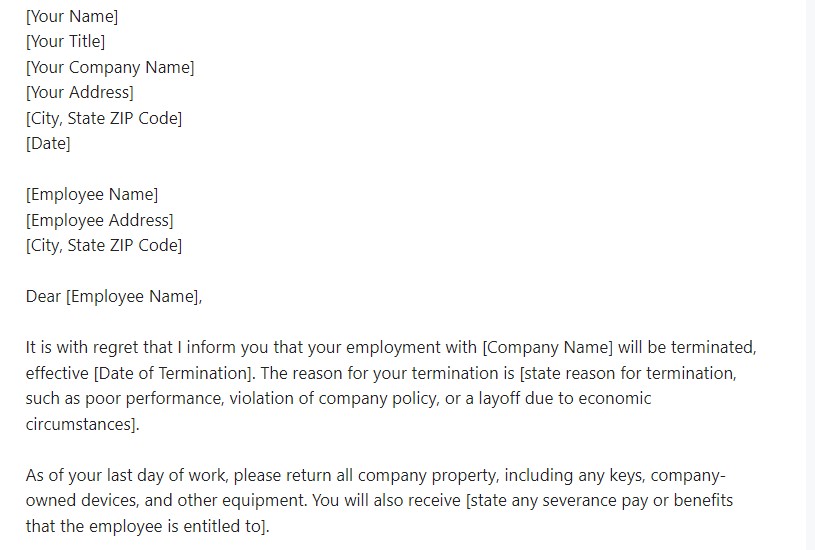A dismissal letter is a formal document used to terminate the employment of an employee.
Here are some frequently asked questions (FAQs) regarding dismissal letters:
Q: What is a dismissal letter?
A: A dismissal letter is a formal document used to terminate the employment of an employee.
Q: When should a dismissal letter be used?
A: A dismissal letter should be used when an employer needs to terminate the employment of an employee for any reason, such as poor performance, misconduct, or a layoff due to economic circumstances.
Q: What should be included in a dismissal letter?
A: A dismissal letter should include the reason for the termination, the date of termination, any severance pay or benefits that the employee is entitled to, and any instructions regarding the return of company property.
Q: Is a dismissal letter required by law?
A: In most cases, a dismissal letter is not required by law, but it is advisable to provide a written document that clearly states the reason for the termination in order to avoid any misunderstandings or disputes.
Q: Can a dismissal letter be challenged in court?
A: A dismissal letter can be challenged in court if the employee believes that the termination was wrongful or discriminatory. It is important to seek legal advice if you are unsure about the legal implications of the dismissal.
Q: Can a dismissal letter be delivered in person or over the phone?
A: While a dismissal letter can be delivered in person or over the phone, it is advisable to provide a written document that clearly states the reason for the termination in order to avoid any misunderstandings or disputes.
Here are some tips on how to write a dismissal letter:
1. Be clear and concise: Clearly state the reason for the dismissal in the opening sentence or paragraph.
2. Be professional and respectful: Use professional and respectful language throughout the letter, even if the dismissal is due to misconduct or poor performance.
3. Provide necessary details: Provide any necessary details, such as the last day of work, the reason for the dismissal, and any severance pay or benefits that the employee is entitled to.
4. Keep a record: Keep a copy of the dismissal letter for your records, and make sure that the employee signs and acknowledges receipt of the letter.
5. Seek legal advice: If you are unsure about the legal implications of the dismissal or the wording of the letter, it is advisable to seek legal advice.
Here is a sample dismissal letter:
[Your Name]
[Your Title]
[Your Company Name]
[Your Address]
[City, State ZIP Code]
[Date]
[Employee Name]
[Employee Address]
[City, State ZIP Code]
Dear [Employee Name],
It is with regret that I inform you that your employment with [Company Name] will be terminated, effective [Date of Termination]. The reason for your termination is [state reason for termination, such as poor performance, violation of company policy, or a layoff due to economic circumstances].
As of your last day of work, please return all company property, including any keys, company-owned devices, and other equipment. You will also receive [state any severance pay or benefits that the employee is entitled to].
We appreciate the contributions that you have made during your time at [Company Name], and we wish you all the best in your future endeavors.
Please acknowledge receipt of this letter by signing and returning the enclosed copy.
Sincerely,
[Your Name]
